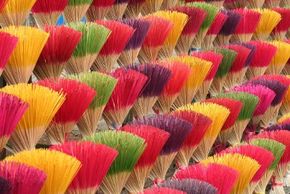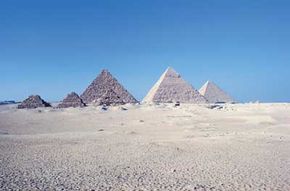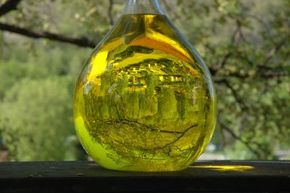In ancient times, as now, commonly used essential oils such as frankincense, eucalyptus, ginger, patchouli, and rosewood came from the furthest reaches of the globe. These vital components of religious ceremonies, medicine, food, cosmetics, and aphrodisiacs were in great demand and were more costly than precious metals and jewels. Although each region could produce clothing, shelter, and food from the resources in its immediate territory, people of all nations craved rare, exotic odors that literally added spice to their lives and lent an air of mystery to their ceremonies.
The demand for aromatic materials, coupled with their portability, led to the establishment of long distance trade. Fortunately, seeds and herbs could be dried, gums rolled into beads, and fragrances infused in oil or solid perfumes while retaining or even improving their properties. This made them extremely portable and relatively impervious to damage.
With trade and the passion for fragrance came adventure and intrigue. Fleets of ships crossed oceans, explorers risked their lives traveling across vast deserts, wars were ignited over land disputes and trade rights, kingdoms were conquered or lost, and love bloomed -- all in the pursuit of fragrance. As a result, the quest for fragrance was responsible for molding early world history more than any other single factor.
Babylonian Beginnings
No one knows exactly when trade began, but an import order for cedarwood, myrrh, and cypress was found inscribed on an early Babylonian clay tablet. More than 5,000 years ago, when Egyptians were just learning to write and make bricks, they were already bringing in large quantities of myrrh -- their most valued trade import. Certainly there were trade routes through the Middle East to obtain myrrh and other fragrant goods before 2000 B.C.E., and these routes were well-traveled for the next 30 centuries.
Overland trade meant grueling months or even years crossing arid deserts and negotiating difficult mountain passes while being threatened by bandits. So aromatics were soon transported by sea, leading to improvements in sailing techniques, vessels, and navigation. Monsoon winds carried double-outrigger canoes along the cinnamon route through the South Seas. Later, Egyptian and eventually Roman traders took advantage of these same winds to take them to India in the summer and home again in the winter.
The Scent of Royalty
Wheeling and dealing is not a new art, but it was fully employed in the ancient fragrance trade. The great Egyptian Queen Hatshepsut, for one, knew a business opportunity when she saw one. As one of her greatest accomplishments, she sent an expedition to Punt on the African coast to establish what would be a very profitable trade. She also brought back 31 myrrh trees to Egypt, and they were planted in a botanical garden that lined the walkway leading to her massive temple of Deir al-Bahari near Thebes. On the temple walls, the images of the myrrh trees carved in bas-relief can still be seen today.
Other queens made an equal impact on aromatic history. When the Queen of Sheba paid her famous visit to the court of Israel's King Solomon, it was to discuss the fragrance trade. Some sources say she was from southwestern Arabia, the land of frankincense and myrrh, but more likely she was queen of a North Arabian tribe that traded the fragrant terebinth resin from the pistachio tree.
Sometimes fragrance simply tagged along in the footsteps of the famous. For example, Alexander the Great's conquests had little to do with the pursuit of fragrant materials. In fact, he despised fragrances because they reminded him of his Persian enemies, and he contemptuously threw out a box of priceless ointments from King Darius' tent after defeating him at the battle of Issos. However, after a few years of traveling through Asia, he became convinced of the joys of fine scent. He anointed his body with fragrant oils and kept incense burning by his throne. And, in his wake, he left the lands he conquered desiring more aromatics.
A World Market
Today, cities prosper and fail with the price of oil. So, too, did they in ancient times; however, it was fragrant oils and spices, not fuel oil, that sparked the growth of key cities along the avenues of commerce. With the introduction of camels as pack animals, the city of Alexandria developed into an active trading hub linking several trade routes, including one to Arabia, 2,000 miles away.
By the fourth century B.C.E., Babylon had a thriving market, trading in cedar of Lebanon, cypress, pine, fir resin, myrtle, calamus, and juniper. Athens was famous for its hundreds of shops selling scented body oils and solid incense/perfumes. Phoenician merchants dealt in Chinese camphor, Indian cinnamon, black pepper, and sandalwood. Africa, South Arabia, and India supplied lemongrass, ginger, and spikenard, the rhizome of which has an exotic fragrance. China imported jasmine-scented sesame oil from India and Persia, rose water via the Silk Route, and eventually, Indonesian aromatics: cloves, gum benzoin, ginger, nutmeg, and patchouli. Astute traders knew which locales produced the best oils and fragrances.
Redolent Wealth
Since ancient times, the wealthy and powerful have been able to drown themselves in fragrance. In fact, one unfortunate Roman literally did. He was asphyxiated when the carved ivory ceiling panels in Emperor Nero's dining room slid aside to shower guests, who reclined on floor pillows, with hundreds of pounds of fresh rose petals. In general, wealthy Romans so over-indulged themselves in fragrance that the ruler Leptadeni, in 188 B.C.E., issued an edict forbidding such foolish excess.
The Roman population paid little heed to the fragrance prohibition, and demand for incense only increased. By the first century C.E., Romans were burning 2,800 tons of imported frankincense and 550 tons of myrrh -- both herbs more costly than gold -- each year. As a result, Emperor Augustus increased the number of trade ships sailing between Egypt and India fivefold, from twenty to a hundred.
Islamic culture was also rich in fragrance, using it extensively in medicine, cosmetics, and confections. Rose water was mixed into the mortar used to build mosques, and even the ground in paradise was said to emit the scent of musk and saffron. Mohammed himself was once a spice and aromatics merchant who traveled on camel caravans. He loved fragrance, especially rose, mentioning it frequently in his teachings: "Whoever would smell my scent, let him smell the rose."
Linking East and West
Although certainly not the intention, the Crusades of the eleventh, twelfth, and thirteenth centuries acquainted the European population with Arabian ideas and fostered an appreciation of Eastern aromatics, despite repeated warnings by the Christian priesthood that fragrance was associated with Satan. Crusaders returned bearing gifts of oils, fragrant waters, and solid perfumes. Soon the European elite were demanding rose water, and Italians could not live without the addition of orange water to their sweets and confections.
As commerce in fragrance increased between East and West, so did the exchange of ideas. To facilitate trade the Chinese adopted the Indian system of counting. By the eleventh century, Arabs were navigating spice-laden ships from India to China with the Chinese compass and balanced stern rudder. During the next century, the Chinese navy grew from 3,000 to 50,000 sailors to accommodate large vessels that each hauled as much as six thousand baskets of fragrant herbs and spices.
China's upper classes were lavish in their use of scent, especially from the seventh century T'ang Dynasty through the Ming Dynasty in the seventeenth century. Everything was scented -- baths, clothing, buildings, ink, and paper. Miniature landscapes, in which perfumed smoke escaped from a mountain and coiled around the peak, became the rage.
Exploration and Colonization
Marco Polo made his famous journey to Kublai Khan's court in the late thirteenth century to establish direct trade between Italy and China. The Italians could thus circumvent Muslim middlemen and their 300 percent markup. The deal was successful, and throughout the thirteenth and fourteenth century Italy monopolized Eastern trade with Europe. Not to be outdone, Spain sent Christopher Columbus across the ocean to seek a shorter route to India.
It was the Portuguese who established a sailing route to India that circumvented Alexandria and Constantinople. In 1498, Vasco de Gama's sailors cheered, "For Christ and spices!" as they reached India, land of fragrant spices and herbs. They brought back so much that nutmegs were said to be rolling in the streets of Lisbon!
Early in the seventeenth century the Dutch built forts in India, establishing the Dutch East India Company by force. In provinces where they couldn't obtain control, they simply uprooted nutmeg and clove trees so no one else could have them. But the French managed to slip several fragrant plants out from under the Dutch noses. These were planted in the French West Indies and the island of Bourbon (now called Reunion).
The demand for essential oils and spices really started to escalate with the invention of incense and solid perfumes. We'll learn about this development in the next section.
To learn more about Aromatherapy and other alternative medicines, see:
- Aromatherapy: Here you will learn about aromatherapy, how it works, what part essential oils play, and how to use aromatherapy.
- Essential Oils Profiles: We have collected profiles of dozens of plants that are used to produce essential oils. On these pages, you will learn the properties and preparations for the most popular essential oils.
- How to Treat Common Conditions With Aromatherapy: Aromatherapy can be used to treat a number of conditions, from asthma to depression to skin problems. Here you will learn how to treat some common medical problems with aromatherapy.
- Home Remedies: We have gathered over a hundred safe, time-tested home remedies for treating a wide variety of medical complaints yourself.
- Herbal Remedies: Herbal remedies and aromatherapy can be very similar, and they stem from similar historic roots. On this page, you will find all of our herb profiles and instructions for treating medical problems with herbal remedies.
This information is solely for informational purposes. IT IS NOT INTENDED TO PROVIDE MEDICAL ADVICE. Neither the Editors of Consumer Guide (R), Publications International, Ltd., the author nor publisher take responsibility for any possible consequences from any treatment, procedure, exercise, dietary modification, action or application of medication which results from reading or following the information contained in this information. The publication of this information does not constitute the practice of medicine, and this information does not replace the advice of your physician or other health care provider. Before undertaking any course of treatment, the reader must seek the advice of their physician or other health care provider.



